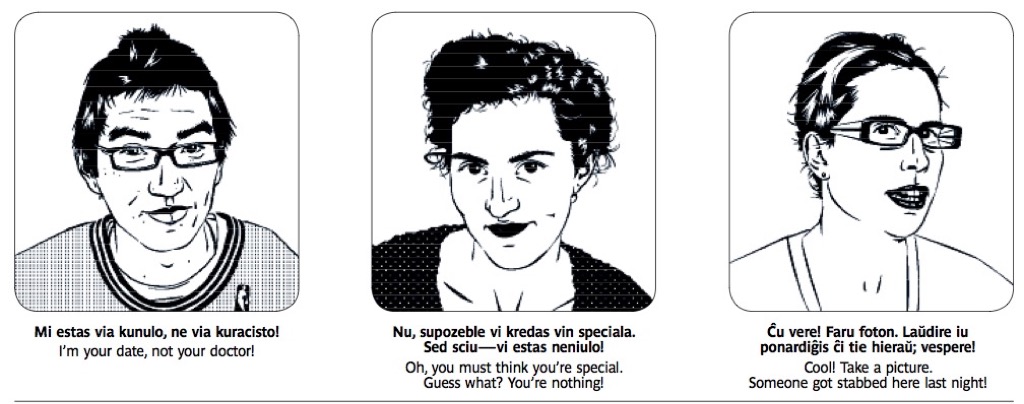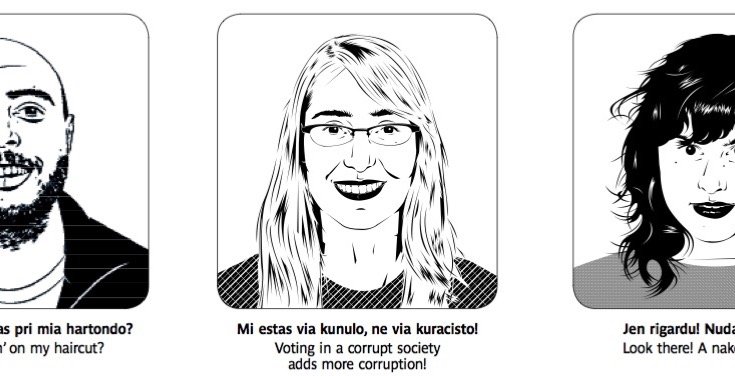You’re sitting at a trattoria in Florence. You’ve had a few glasses of Prosecco and you’re feeling expansive. You order ensalata verde, pesce al basilico, torte al limone. You feel as if, yes, you can actually speak Italian. But this newfound sense of linguistic competence evaporates the next day when you attempt to purchase a train ticket to Rome from a sullen government employee who is working to rule. A hangover headache sets in as you realize that you are still stubbornly monolingual.
Learning a language as an adult can be discouraging. But Esperanto, a language constructed by Polish ophthalmologist and amateur philologist Ludovic Lazarus Zamenhof during the 1880s, seems specifically engineered to keep that initial linguistic optimism—Prosecco-induced or otherwise—from fading. Its rules are reassuringly reliable: consistent pronunciation, regular grammar, and a limited but durable vocabulary. There are no silent p’s, no irregular verbs, no grammatical genders, and few of the colloquial expressions that can get non-native speakers into such a pickle. Esperanto is amuza and facila. In fact, learning Esperanto feels like a bona ideo all round. (See, you’re catching on already.) So why isn’t la tuta mondo joining in
In its short life, Esperanto has been widely praised and roundly denigrated. Leo Tolstoy and J.R.R. Tolkien were early supporters; the ever-paranoid Stalin called it “the language of spies” and oversaw the deaths of an estimated two thousand Soviet Esperantists in purges in 1937, and the imprisonment of thousands more. With the tiresome predictability of the anti-Semite, Hitler saw Esperanto as a Jewish plot, denouncing it in a speech in Munich in 1922 and renewing the attack in Mein Kampf. In 1936, the Nazis outlawed the teaching of Esperanto, and during the war many Esperantists (many of whom were also Jews, Communists, or both), including three of Zamenhof’s children, were murdered.
Today the common belief is that the practice of Esperanto is harmless and irrelevant. After all, English is the new international language—at least that’s a notion accepted with easy complacency by many English speakers. And yet, the Esperanto movement persists. (Esperanto means “one who hopes.”) Though a Danish linguist joked at a 1954 unesco conference that Esperanto was a language “suitable only for Uruguayan menus—“sparking a nasty Danish-Uruguayan diplomatic incident—it is estimated that two million people can now order soup, gossip about Paris Hilton, and possibly even discuss epistemology in Esperanto. Of those, as many as two thousand are actually native speakers who grew up in Esperanto-speaking homes.
From a twenty-first-century viewpoint, Zamenhof’s dream might seem airy, but it was grounded in his day-to-day experiences as a Jew growing up in Bialystok, at that time a corner of the Czarist empire with a fractious population divided into Russian, Polish, German, and Yiddish speakers. Zamenhof felt that the anti-Semitism and ethnic strife he witnessed were exacerbated by communication problems. His scheme for a planned international language was, in its optimism and scientific rationalism, quintessentially nineteenth century, but Zamenhof was also working within a larger tradition, one in which language is a bridge to a utopian dream of perfect understanding, of absolute harmony among what is meant, what is said, and what is heard. In this sense, Esperanto isn’t meant to be merely a convenient way to order a cup of coffee in a distant land; it is a way of imagining the future.

And far from being a quaint relic, Esperanto is a going concern. To promote its vision of global communication, the Rotterdam-based Universala Esperanto-Asocio has been organizing annual congresses all over the world since 1908, interrupted only by the two world wars. Between congresses, Esperantists can watch Esperanto television, thumb through Esperanto magazines, listen to Esperanto rock music on Esperanto radio shows, and read translations of international literature from Turgenev to Tintin, as well as a small body of original Esperanto writing. And in this country, the Kanada Esperanto-Asocio, which numbers around 170 members, offers correspondence courses and a mail-order book service, while friendly gangs of Esperantists in eight Canadian cities gather locally for potluck dinners, game nights, and socials.
Constructed languages, or “conlangs,” as some word-wonks call them, have a long, persistent, and prolific history. (Two major groups of conlangs are artistic languages or “artlangs,” which tend to be constructed for personal or creative reasons, and auxiliary languages, or “auxlangs,” such as Esperanto, which are meant to function as a means of international communication.) In the twelfth century, St. Hildegard of Bingen invented Lingua Ignota, probably as a secret mystical language. In the seventeenth century, Descartes and Leibniz each fantastized about developing philosophical languages that would express truth with the sharp, incontestable accuracy of mathematical equations.
Umberto Eco, in The Search for the Perfect Language, connects these quests to the Babel story in Genesis, which describes the whole earth as being “of one language and one speech” until human beings decide to build a fatally tall tower, compelling God to “confound their language” and scatter them abroad. Eco suggests that this second biblical myth of expulsion, here from the paradise of complete understanding, has preoccupied thinkers and linguistic tinkerers ever since: “Some looked backwards, trying to rediscover the language spoken by Adam. Others looked ahead, aiming to fabricate a rational language possessing the perfections of the lost speech of Eden.”
Early Christian writers tended to believe that the language spoken in the Garden was Hebrew, but as modern Europe began to emerge with all its multilingual complications, writers became more protective of their own languages. (Evidence that the primal tongue was obviously Brabantic Flemish, the Dutch dialect spoken in sixteenth-century Antwerp, was advanced by Johannes Goropius Becanus, who, not surprisingly, lived in sixteenth-century Antwerp.) Eventually the philologists forgot about Eden. With ethnic and national boundaries shifting and stretching, linguistic chauvinists began to bicker over which language deserved supremacy in contemporary Europe, while linguistic idealists looked for a compromise in the form of a universal language. The multilingual scholar Mario Pei, in One Language for the World, reels off what he sees as a wearisome list of proposed auxlangs coming out of an environment of rapid political change in the nineteenth and early twentieth centuries: Idiom Neutral, Mundelingua, Universala, Mondlingvo, and Novial; the briskly named Ao, Eo, Esk, Ile, Is, and Tal; the catchy Perfekt, Simplo, Unita, Expreso, Geoglot, Viva, and Homapar; the inscrutably hard-to-pronounce Oiropa’pitschn, Quji, and Sehlerai.
Inventing, refining, and arguing about constructed languages requires passionate commitment and a certain level of linguistic ability, so it’s not surprising that the movement is full of pedants and people who speak Klingon. Unfortunately for the auxlang side of things, the kind of person who is drawn to a planned language is often the same kind of person who feels compelled to make up his or her very own, which means that widespread acceptance of a universal idiom is constantly being scuppered by self-defeating schisms.
Esperanto has its share of splinter groups—the Riismo movement aims to eliminate sexist usages, for example—but its great crisis came back in 1907 with the “Ido split,” which one Esperantist historian laments as “characterized by a high degree of scheming and conniving and treachery.” The defection of prominent French Esperantist the Marquis Louis de Beaufront to the Ido variant, which he is thought to have helped develop while acting as Zamenhof’s trusted lieutenant, was seen as a perfidious personal and linguistic betrayal. (Esperantists take great pleasure in pointing out that de Beaufront was a fake marquis.) Those pioneering Idists viewed themselves as revolutionaries and the Esperantists as stuffy and short-sighted. The Esperantists, on the other hand, felt that the early Idists suffered from the “constant reform” problem, with their dictionaries becoming outdated even before they were published.
Of course, outsiders wonder what all the fuss is about. Who needs a constructed language when English has emerged as the unofficial lingua franca of the twenty-first century But an aid worker in Mali or an engineer in Malaysia might tell you that the dominion of English is neither as far-reaching nor as uncomplicated as English speakers would like to think. As Wally du Temple, president of the Kanada Esperanto-Asocio, points out, “[English] may be the de facto language for international communication, but it is not the ideal one.” It is powerful, subtle, rich, and gloriously idiosyncratic—all of which make it a magnificent language to be born into and an absolute son of a bitch to learn as an adult. English is so chockablock with figures of speech that entire humour books are based on hapless foreigners inadvertently constructing phrases that are technically correct but idiomatically hilarious—you know, old chestnuts like “Ladies are requested not to have children in the bar.”
Detractors sometimes imagine Esperanto as a grim, grey, official language imposed by a New World Order: the “Newspeak” in George Orwell’s 1984 has sometimes been misidentified as Esperanto, and while Orwell wasn’t a fan—during his down-and-out period he bunked with an aunt and her lover who spoke only in Esperanto, effectively leaving him out of conversations—the language he was satirizing was probably Basic English. (Invented by C.K. Ogden in 1930, Basic reduced the grand sprawl of the English language to 850 words suitable for simple conversations and commercial transactions. Winston Churchill was an early supporter, though he might have been dismayed when his inspirational “Blood, toil, tears, and sweat” wartime speech was translated as “Blood, hard work, eyewash, and body water.”)
Fortunately, Esperanto doesn’t want to deprive us of our mother tongue. It is meant to function as an international second language, meaning that speakers hang on to their native languages while using the auxlang in interactions with the outside world. It has been described as a neutral linguistic handshake, where two speakers of two different languages can meet each other halfway. And sometimes it’s more of a kiss. Du Temple met his future wife, Olga Valentova, in Prague in 1969. He didn’t speak Czech and she didn’t speak English, so they courted in Esperanto, ultimately marrying in 1972 and raising two Esperanto-speaking children in British Columbia.
The Prague Manifesto—the modern Esperanto movement’s statement of purpose, ratified at the Universala Kongreso in 1996—emphasizes the preservation of linguistic diversity. Mark Fettes, an assistant professor of education at Simon Fraser University and a fluent Esperanto speaker, cites studies that demonstrate Esperanto’s “propaedeutic” effect—i.e., that learning Esperanto makes the acquisition of subsequent languages easier. (English-speaking students who studied Esperanto for one year and then French for three years achieved better results than students who studied French for four years, for example.) There is also the notion that having one common medium reserved purely for international exchange would leave people free to cleave to Manx or Welsh or Boro or any of the threatened tongues documented by Mark Abley in his 2003 book Spoken Here: Travels Among Threatened Languages.
Critics charge that Esperanto is too Eurocentric. The alphabet is Latin, the phonology and syntax are Slavic, and the vocabulary is taken from the Romance languages with a smattering of German. Certainly, speakers of European languages will pick up Esperanto more easily than someone who grew up speaking Japanese or Berber. Defenders point out that learning Esperanto—for anybody—is still easier than learning English and that Esperanto has spread beyond its European roots, even without the usual “persuasions” of European imperialism. Non-Western hot spots include post-revolutionary China (where official use of the language was promoted but private use was sometimes looked on with suspicion) and Iran in the 1970s.
The cultural effects of English can be overpowering. Languages don’t become widespread because of their beauty or efficacy: they expand for military, political, and economic reasons. In the case of English, these include the reach of the British Empire in the nineteenth century, the rise of American influence in the second half of the twentieth century, and the domination of English-language mass media and global pop culture in the twenty-first. The current ascendancy of English is therefore freighted with a certain amount of Britney Spears/Diet Coke/General Motors baggage, while Esperanto travels light. For this reason, Esperanto often thrives in areas in which a minority community has a fraught relationship with a dominant language. If you recall the Trainspotting rant about the humiliation of the Scots being colonized by English wankers, you might see why the Scottish School (skota scolo) of Esperanto literature, which includes poet William Auld, flowered like a stubborn thistle in 1950s Glasgow.
Wary of Czarist persecution, Zamenhof felt that Esperanto needed to be stringently neutral in ideological terms. But the movement has always had an affinity for internationalism, egalitarianism, pacifism, and humanism—a constellation of beliefs that are sometimes referred to as the language’s interna ideo (internal idea). Dr. Ivo Lapenna, a Yugoslavian lawyer who was an influential leader in the international movement from 1937 to 1974, clearly felt that the interna ideo had gotten a little too misty when he opened the 1947 Kongreso by castigating that “strong and accented religious-mystical-spiritualistic colour, with a mass of naiveties and frivolities, which only compromises the cause of the International Language.” Lapenna dismissed spiritualists, the Oxford Group, Rotarians, and the Baha’i religion. He even went after such harmless souls as Esperanto stamp collectors and a lady who advocated wearing green stockings (green is the emblematic colour of the movement). Lapenna later got a bee in his bonnet about Communist Esperantists. Present-day Esperantists tend to avoid specific religious and political affiliations but are often involved with the social-justice movement, peace advocacy, international development, and environmentalism.
Esperanto has a flag, an anthem, and a holiday. (Some people celebrate December 15, Zamenhof Day, by buying Esperanto books.) Just as an Esperanto culture has developed in spite of Zamenhof’s initial reservations, so too have idioms. In the interest of simplicity and ease of learning, these were originally restricted to a few very specific expressions, such as krokodili (to crocodile), which means to speak a muddled hybrid of one’s national tongue and Esperanto, or Esperanto-Edzperanto, loosely translated as “Esperanto matchmaker,” meaning the experience of falling in love through the practice of Esperanto. Zamenhof, who was pretty pragmatic for a nineteenth-century idealist, declared that he “abandoned for all time all personal rights over [Esperanto],” recognizing that the language was bound to change and grow far beyond him. Modern-day Esperanto has been updated to include computer (komputilo) terms, for instance, just like any other living language.
And slang thrives, especially on the Wild West frontier of the Internet, which du Temple sees as the biggest forum for Esperanto education and information in the last decade. Websites by college kids and creative wordsmiths attempt to give Esperanto a little street cred with such phrases as kiel zumas, (how’s it buzzin’), neshvite (no sweat), or even fikighu (just in case you forget the interna ideo long enough to say “fuck you”). There is also an X-rated web update of National Lampoon’s 1972 classic “How To Talk Dirty in Esperanto.” It seems that being filthy is not only more fun in Esperanto, it also retains an adorable innocence, even when sample sentences involve randy Esperantists doing unspeakable things with their pizangoj (big plantains). Proof that this site is the work of sophisticated linguists can be seen in the fine distinction between the transitive and intransitive forms of “to sodomize.”
Appended to Zamenhof’s first brochure in 1887 was a sheet asking anyone interested to sign a promise that he or she would learn Esperanto when ten million other people had also made that pledge. Once again Zamenhof demonstrated his practical view of human nature, recognizing that a universal language is exactly the kind of visionary project that people will embrace only once everyone else is embracing it too. Almost 120 years later, Zamenhof’s dream has not yet hit its quota. Still, to dismiss the Esperanto project as a failure is too easy, and perhaps too cynical. Of the hundreds of planned language schemes born out of the polyglot polemics of turn-of-the-twentieth-century Europe, Esperanto is the one that has endured long enough and spread far enough to take on a continuous and collective life. There is something tender and hopeful about the modern-day Esperantists, who read, write, sing, and, yes, talk dirty in nia kara lingvo (our dear language) even without the assurance that ten million people will soon be joining them. To be an idealist in the nineteenth century was easy. To be an idealist in 2006 requires a very tough, very stubborn kind of faith.





